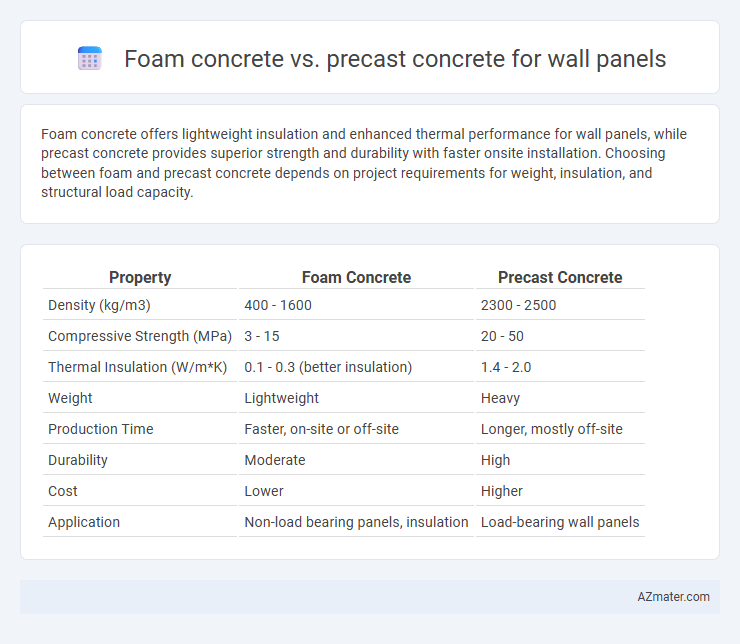Foam concrete offers lightweight insulation and enhanced thermal performance for wall panels, while precast concrete provides superior strength and durability with faster onsite installation. Choosing between foam and precast concrete depends on project requirements for weight, insulation, and structural load capacity.
Table of Comparison
| Property | Foam Concrete | Precast Concrete |
|---|---|---|
| Density (kg/m3) | 400 - 1600 | 2300 - 2500 |
| Compressive Strength (MPa) | 3 - 15 | 20 - 50 |
| Thermal Insulation (W/m*K) | 0.1 - 0.3 (better insulation) | 1.4 - 2.0 |
| Weight | Lightweight | Heavy |
| Production Time | Faster, on-site or off-site | Longer, mostly off-site |
| Durability | Moderate | High |
| Cost | Lower | Higher |
| Application | Non-load bearing panels, insulation | Load-bearing wall panels |
Introduction to Foam Concrete and Precast Concrete
Foam concrete is a lightweight, aerated material composed of cement, water, and foaming agents, offering excellent thermal insulation and reduced structural load for wall panels. Precast concrete is a factory-produced, high-strength material formed and cured under controlled conditions, delivering superior durability and dimensional accuracy for wall panel applications. Both materials provide distinct advantages in construction efficiency, with foam concrete emphasizing insulation and weight savings, while precast concrete prioritizes strength and precision.
Material Composition and Manufacturing Process
Foam concrete for wall panels consists of cement, water, fine aggregates, and a foaming agent that introduces air bubbles, creating a lightweight and insulating material with low density. Precast concrete wall panels are produced using a mixture of cement, coarse aggregates, fine aggregates, water, and admixtures, poured into molds and cured under controlled conditions to achieve high strength and durability. Foam concrete manufacturing involves mixing base materials with foam to create uniform cellular structure, while precast concrete panels are cast in factory settings allowing for precise shaping, reinforcement placement, and quality control.
Structural Strength and Load-Bearing Capacity
Foam concrete offers lightweight properties with moderate structural strength, making it suitable for non-load-bearing wall panels and providing excellent thermal insulation. Precast concrete exhibits superior load-bearing capacity and higher compressive strength, ideal for structural wall panels requiring substantial durability and resistance to heavy loads. Selecting between foam and precast concrete depends on project demands for strength, weight, and insulation performance in wall panel applications.
Thermal and Acoustic Insulation Properties
Foam concrete offers superior thermal insulation due to its lightweight, porous structure that traps air, significantly reducing heat transfer compared to denser precast concrete panels. Acoustic insulation is enhanced in foam concrete walls as the air voids absorb sound waves, providing better noise reduction, whereas precast concrete panels require additional insulation materials for comparable soundproofing. The inherent properties of foam concrete make it ideal for energy-efficient buildings demanding both thermal and acoustic comfort.
Installation and Construction Speed
Foam concrete wall panels offer lightweight properties that significantly reduce handling and installation time on-site, accelerating overall construction speed compared to traditional precast concrete panels. The ease of cutting and shaping foam concrete enables faster customization, minimizing delays associated with adjustments during installation. Precast concrete panels, while durable and strong, often require heavier equipment and longer curing times, which can extend project timelines in comparison to the rapid-setting, less labor-intensive foam concrete alternatives.
Durability and Maintenance Requirements
Foam concrete wall panels offer excellent thermal insulation and are resistant to fire and pests but generally have lower compressive strength compared to precast concrete, impacting long-term durability under heavy structural loads. Precast concrete panels provide superior durability due to higher density, robust strength, and enhanced resistance to weathering, making them ideal for external walls requiring low maintenance over time. Maintenance requirements for foam concrete panels may increase due to potential surface wear and moisture absorption, whereas precast concrete panels typically demand minimal upkeep, preserving structural integrity and appearance for decades.
Design Flexibility and Customization Options
Foam concrete offers superior design flexibility for wall panels due to its lightweight nature and ease of molding into complex shapes, enabling intricate architectural features and varied thicknesses. Precast concrete provides strong customization options through factory-controlled production, allowing precise dimensioning, surface finishes, and embedded inserts but is limited by transportation size constraints. The choice between foam concrete and precast concrete depends on balancing the need for detailed design versatility with structural strength and manufacturing scalability.
Cost Comparison: Initial Investment and Long-Term Savings
Foam concrete wall panels generally require a lower initial investment due to reduced material and transportation costs, while precast concrete panels often demand higher upfront expenses because of complex mold manufacturing and heavy equipment. Long-term savings with foam concrete arise from superior thermal insulation properties, reducing energy costs significantly over the building's life cycle. Precast concrete provides durability and strength that may lower maintenance costs but typically lacks the insulation efficiency seen in foam concrete panels.
Environmental Impact and Sustainability Factors
Foam concrete offers superior environmental benefits due to its lightweight nature, requiring less raw material and reducing transportation emissions compared to denser precast concrete wall panels. Its insulating properties enhance energy efficiency in buildings, contributing to lower operational carbon footprints, while precast concrete, although durable, typically involves higher energy consumption during manufacturing and has a larger embodied carbon footprint. Sustainable construction favors foam concrete for reduced waste generation and improved recyclability, aligning with green building certifications and eco-friendly design principles.
Ideal Applications and Limitations for Wall Panels
Foam concrete wall panels offer excellent thermal insulation and lightweight properties, making them ideal for non-load-bearing partitions and soundproofing in residential and commercial buildings. Precast concrete wall panels provide superior structural strength and durability, suitable for load-bearing walls and exterior facades in industrial and high-rise construction. Foam concrete's limited compressive strength restricts its use in structural applications, while precast concrete panels may require longer curing times and heavier equipment for installation.

Infographic: Foam concrete vs Precast concrete for Wall panel
 azmater.com
azmater.com